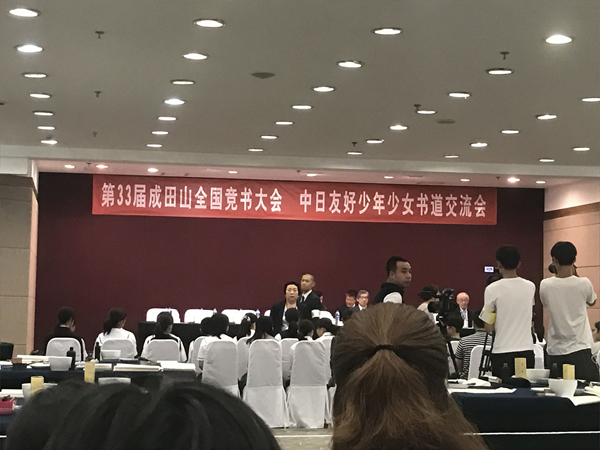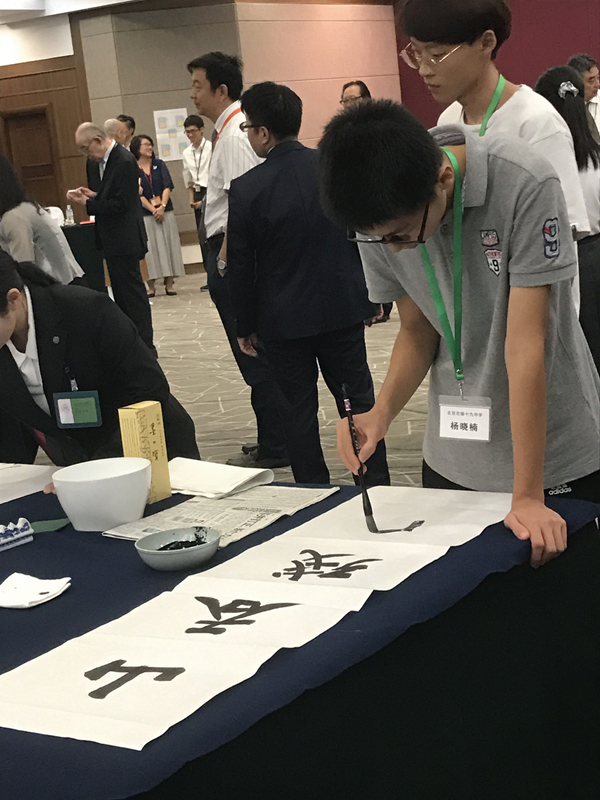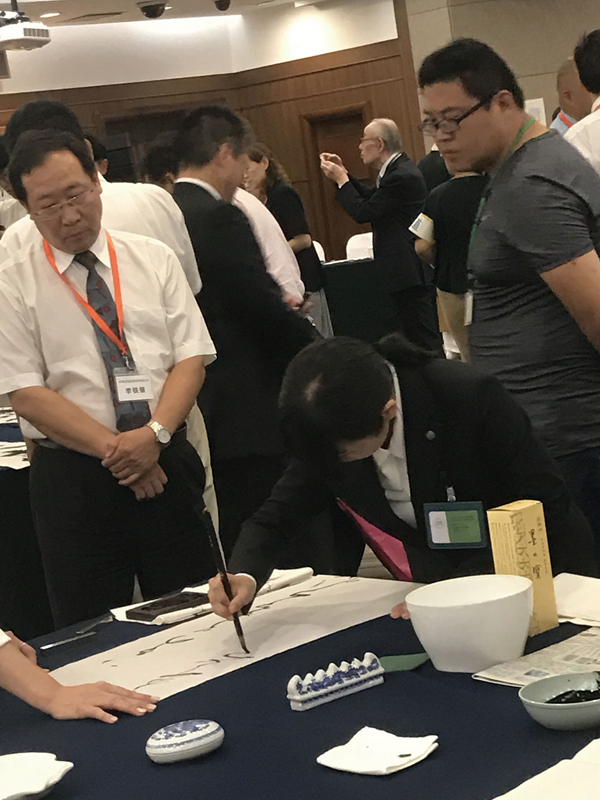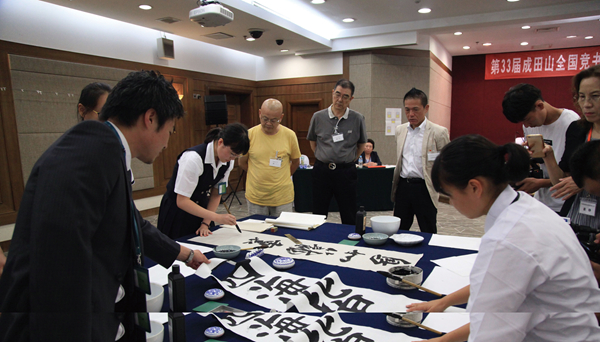Collision between School of Tradition and Fashion of Modernity
——on the China-Japan Friendship Teenager Calligraphy Exchange of the 33rd JNNCC




Scene of the Calligraphy Exchange
There was a fierce competition between every participant, and there was a warm moment when the rival kids helped one another with paper and ink preparation. Both took place in the China-Japan Friendship Teenager Calligraphy Exchange of the 33rd Japanese Naritasan National Calligraphy Competition (JNNCC). At the invitation of China Calligraphers Association (CCA),a 46-member Japan-China Friendship Teenager Calligraphy Exchange delegation, headed by Kishida Teruyasu, vice president of JNNCC and CEO of Shinshoji Temple, visited China for exchanges from August 4 till 7. On August 5, China-Japan Teenager Calligraphy Exchange was held in Beijing.
Initiated in 1985, JNNCC is an annual nationwide calligraphy competition in Japan that collects calligraphic works by pupils of primary and secondary schools and even kindergartens for final comments by renowned Japanese calligraphers. In the past 33 years, approximately 700000 teenagers have participated in this competition with some 3 million pieces of calligraphy, much so so that JNNCC has become the most influential teenager calligraphy competition in Japan. Every year, the organizing committee of JNNCC sends a delegation of award-winners to China for exchange.
Oota Chihiro, a student of grade three of high school who has won "Lanting New Star Award" by CCA, was one of the 14 delegates from Japan. As for others, they are all winners of nationwide calligraphy competitions in Japan in 2017 and thus proven as blessed with outstanding talents in calligraphy. As for Chinese side, the 14 attendees were all students of elementary and secondary schools from Chaoyang, Haidian and Dongcheng Districts of Beijing. Though the youngest was only at the age of eleven, they were invariably qualified with a solid foundation of calligraphy.
He Qiyetu, vice president of CCA, remarked at his speech, "As calligraphy is an intangible cultural heritage of mankind, it has become a common responsibility for the global calligraphy community to preserve, inherit and promote this art. It is indeed an important measure of promoting calligraphy as an art to organize teenagers' calligraphy competition and conduct extensive exchanges on the international occasion. We sincerely expect that teenagers' calligraphy exchange between China and Japan may witness constant development from generation to generation".
It was an improvised calligraphy exchange on the same arena jointly by teenagers from China and Japan. As guests, Japanese delegates took the lead and then Chinese peers followed in the final co-production. Though such a situation was quite like a fierce competition between athletes, those young calligraphers talked with each other from time to time and helped each other with paper and ink preparation when ever necessary. Such good manners showcased friendship and enthusiasm between teenagers of the two countries and fulfilled the theme purpose of this exchange.
In Japanese calligraphy and Chinese calligraphy, WANG Xizhi, the Saint Master of Calligraphy, is a must-known sample to follow in the process of calligraphy practice. As early as in the 3rd century, WANG Xizhi's calligraphy was introduced to Japan. Having undergone a significant evolution through centuries, today's Japanese calligraphy has presented a totally different outlook from that in China. From those teenagers' improvised calligraphy, we can obviously see a sharp contrast between calligraphy development tendencies in China and Japan.
As to the style of calligraphy, Chinese side seemed to have more abundant variety in dots and strikes. Upon first touch of brush tip on paper, Chinese teenagers will choose varied movements in gradual intensification. By contrast, Japanese teenagers will never hesitate on the first touch and write with natural grace at a dash. Certainly, the obvious difference lied in the layout of their calligraphy works. "Wow, what an imposing manner!" WANG Xinyuan, a Chinese teenager acclaimed at the sight of the improvised calligraphy by Kinra Kennosuke from Japan. Compared with the elegant blank in the above and below margins of any calligraphy works in Chinese habit, Japanese calligraphers prefer to fill the whole scrip as much as possible and their momentum causes a strong visual impact.
Though out of the same origin as WANG Xizhi, Chinese and Japanese calligraphies have presented different styles at present, which is mainly attributed to their different positions in calligraphy development. With dominant respect for the ancient samples and traditions for thousands of years, Chinese calligraphy prefers tradition. In the Japanese process of calligraphy learning, they are never satisfied with mere copying and are courageous enough to integrate modernity into the new fashion of calligraphy.
This exchange was indeed a collision between the school of tradition and the fashion of modernity, and it was believed that both sides would gain more by doing more thinking in the future calligraphy practice.
"I must mention Tamura Akane whose action moved me greatly. Before she started writing her works, she took out the frame photo of her tutor who had just passed away and respectfully placed it in front of her. Such a considerate act in this significant event of China-Japan calligraphy exchange fully embodied her adoration and love for her tutor, and deeply represented the basic quality of respecting the teacher and revering teachings for any calligraphers." LI Yi, advisor of CCA, commented. He also encouraged teenagers of China and Japan to master the true essence of calligraphy by mutual learning and reference, and thus become the backbone for calligraphy inheritance.














